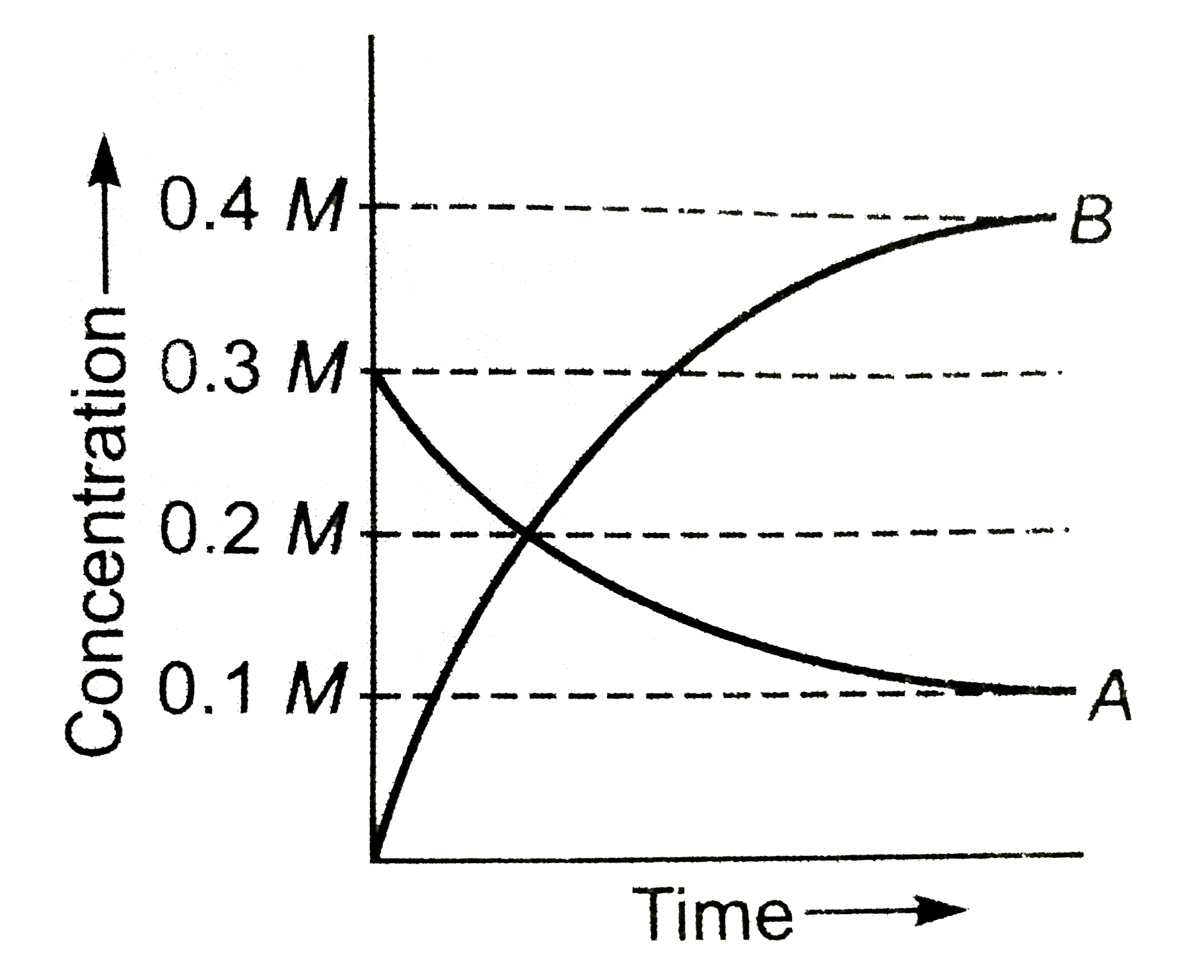A reaction, A(g)+2B(g)⇔2C(g)+D(g) was studied using an initial concentraction of A and B were found to be equal. The value of KP for the equilibrium is
4
6
8
12
The correct Answer is:A
To find the value of Kp for the reaction A(g)+2B(g)⇌2C(g)+D(g), we will follow these steps:
Step 1: Define Initial Concentrations
Let the initial concentration of A be (A)0=A and the initial concentration of B be (B)0=1.5A.
Step 2: Set Up the Change in Concentrations
As the reaction proceeds to equilibrium, let x be the amount of A that reacts. Therefore, at equilibrium:
- The concentration of A will be (A)=A−x
- The concentration of B will be (B)=1.5A−2x
- The concentration of C will be (C)=2x
- The concentration of D will be (D)=x
Step 3: Apply the Equilibrium Condition
We are given that at equilibrium, the concentrations of A and B are equal:
A−x=1.5A−2x
Step 4: Solve for x
Rearranging the equation:
A−x+2x=1.5A
A+x=1.5A
x=0.5A
Step 5: Substitute x Back to Find Concentrations
Now substituting x back into the equilibrium concentrations:
- (A)=A−0.5A=0.5A
- (B)=1.5A−2(0.5A)=0.5A
- (C)=2(0.5A)=A
- (D)=0.5A
Step 6: Write the Expression for Kc
The equilibrium constant Kc is given by:
Kc=(C)2(D)(A)(B)2
Substituting the equilibrium concentrations:
Kc=(A)2(0.5A)(0.5A)(0.5A)2
Kc=A2⋅0.5A0.5A⋅0.25A2=0.5A30.125A3=4
Step 7: Relate Kp to Kc
The relationship between Kp and Kc is given by:
Kp=Kc(RT)Δn
Where Δn is the change in moles of gas:
- Moles of products: 2+1=3
- Moles of reactants: 1+2=3
Thus, Δn=3−3=0.
Step 8: Calculate Kp
Since Δn=0:
Kp=Kc(RT)0=Kc⋅1=4
Final Answer
The value of Kp is 4.
---
Let the initial concentration of A be (A)0=A and the initial concentration of B be (B)0=1.5A.
As the reaction proceeds to equilibrium, let x be the amount of A that reacts. Therefore, at equilibrium:
- The concentration of A will be (A)=A−x
- The concentration of B will be (B)=1.5A−2x
- The concentration of C will be (C)=2x
- The concentration of D will be (D)=x
We are given that at equilibrium, the concentrations of A and B are equal:
A−x=1.5A−2x
Rearranging the equation:
A−x+2x=1.5A
A+x=1.5A
x=0.5A
Now substituting x back into the equilibrium concentrations:
- (A)=A−0.5A=0.5A
- (B)=1.5A−2(0.5A)=0.5A
- (C)=2(0.5A)=A
- (D)=0.5A
The equilibrium constant Kc is given by:
Kc=(C)2(D)(A)(B)2
Substituting the equilibrium concentrations:
Kc=(A)2(0.5A)(0.5A)(0.5A)2
Kc=A2⋅0.5A0.5A⋅0.25A2=0.5A30.125A3=4
The relationship between Kp and Kc is given by:
Kp=Kc(RT)Δn
Where Δn is the change in moles of gas:
- Moles of products: 2+1=3
- Moles of reactants: 1+2=3
Thus, Δn=3−3=0.
Since Δn=0:
Kp=Kc(RT)0=Kc⋅1=4
The value of Kp is 4.
Topper's Solved these Questions
- BOOK - VMC MODULES ENGLISHCHAPTER - CHEMICAL EQUILIBRIUMEXERCISE - IMPECCABLE50videos
CHEMICAL EQUILIBRIUM
- BOOK - VMC MODULES ENGLISHCHAPTER - CHEMICAL EQUILIBRIUMEXERCISE - Illustration24videos
CHEMICAL EQUILIBRIUM
- BOOK - VMC MODULES ENGLISHCHAPTER - CHEMICAL EQUILIBRIUMEXERCISE - ENABLE49videos
CHEMICAL EQUILIBRIUM
- BOOK - VMC MODULES ENGLISHCHAPTER - CHEMICAL BONDING-I & IIEXERCISE - JEE Advanced (Archive)98videos
CHEMICAL BONDING-I & II
- BOOK - VMC MODULES ENGLISHCHAPTER - CHEMICAL KINETICS EXERCISE - JEE Advanced (Archive)52videos
CHEMICAL KINETICS
Similar Questions
A reaction, A(g)+2B(g)⇔2C(g)+D(g) was studied using an initial concentraction of B which was 1.5 times that of A. But the equilibrium concentrations of A and B were found to be equal. The vlue of Kp for the equilibrium is
View SolutionThe reaction,
2A(g)+B(g)⇔3C(g)+D(g)
is begun with the concentration of A and B both at an intial value of 1.00 M. When equilibrium is reached, the concentration of D is measured and found to be 0.25 M. The value for the equilibrium constant for this reaction is given by the expression:View SolutionIn a chemical reaction , A+2BK⇐⇒2c+D, the initial concentration of B was 1.5 times of the concentrations of A , but the equilibrium concentrations of A and B were found to be equal . The equilibrium constant (K) for the aforesaid chemical reaction is :
View SolutionIn a chemical reaction , A+2BK⇐⇒2c+D, the initial concentration of B was 1.5 times of the concentrations of A , but the equilibrium concentrations of A and B were found to be equal . The equilibrium constant (K) for the aforesaid chemical reaction is :
View SolutionFor the reaction:
2A(g)+B(g)⇔3C(g)+D(g)
Two moles each of A and B were taken into a flask. The following must always be true when the system attained equilibriumView SolutionThe figure shows the change in concentration of species A and B as a function of time.
The equilibrium constant Kcfor the reactionA(g)⇔2B(g) is :
 View Solution
View SolutionTwo moles of each reactant A and B are taken in a reaction flask. They react in the following manner,
A(g)+B(g)⇔C(g)+D(g)
At equilibrium, it was found that the concentration of C is triple to that of B the equilibrium constant for the reaction isView SolutionIn the following reaction, 3A(g)+B(g)⇔2C(g)+D(g), Initial moles of B is double at A . At equilibrium, moles of A and C are equal. Hence % dissociation is :
View SolutionThe following equilibrium exists in a closed vessel in 1L capacity A(g)+3B(g)⇔4C(g)
initial cocentration of A(g) is equal to that B(g). The equilibrium concentration of A(g) and C(g) are equal. Kc for the reaction isView SolutionA(G)+B(g)⇔C(g)+D(g)
Above equilibrium is established by taking A& B in a closed container. Initial concentration of A is twice of the initial concentration of B. At equilibrium concentraons of B and C are equal. Then find the equilibrium constant for the reaction, C(g)+D(g)⇔A(g)+B(g).View Solution
